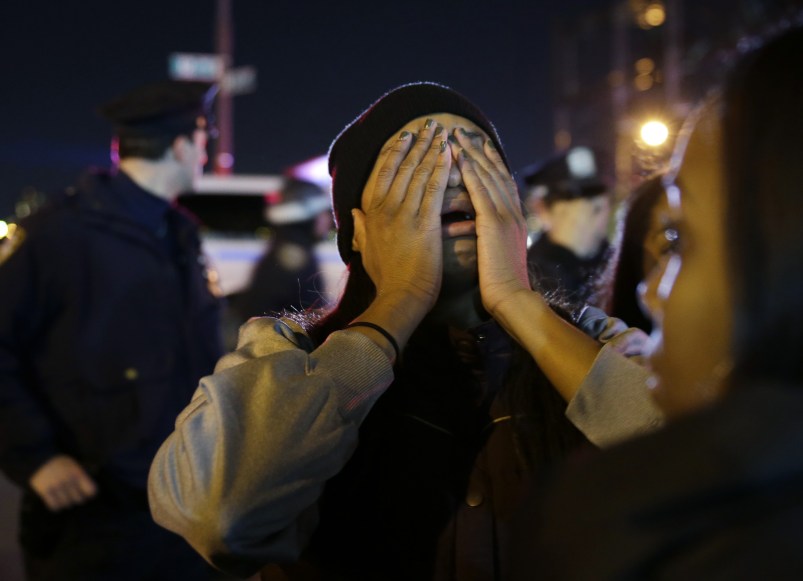#ICantBreathe. Actually, I can’t watch the videos.
I can’t look at the photographs without tensing and tearing up. I can’t put my hands up because my arms are so tired. And I am shot. Through the heart. Through the head. Through the soul. There have been so many people back to back, and there always are. The past few months have been different, though. The photographs and videos have circulated through social and traditional media. Images of the last moments of a father’s life. Of a son’s life. Of a child at play. Children with toys that are as American as apple pie. Their last moments, captured, witnessed, seen, shared with the world.
And here is the thing. These images aren’t new. They are as American as super-sized menu items. The skeleton in our closet has been kept in the historical record of lynching postcards, and shows that we’ve been here before. The only new thing is technology and our reaction to it.
After Ferguson, there were calls for police officers to be fitted with body cameras to make sure that the supposed bad apples can be held accountable. We somehow believe that the technological witness will be able to capture some truth that would otherwise be lost. In the midst of Ferguson, we saw John Crawford III, Tamir Rice, and countless others die in the same way. Even if we didn’t want to, their images circulating through social media made us bear witness to their unnatural deaths. The final, strangling rallying cry of all of these, “I can’t breathe,” repeated 11 times, can be heard even in silence.
People who are not as obviously touched by the violence of law enforcement are able to see the first person view from security, police, and civilian cams. The violence is real. The outcome, regardless of what is captured, keeps power as it was. We do not question, though, that these cameras are a form of protection. We see them as a potential for justice, even if they failed this time. People who hoped that seeing that brutality of someone killed would cause a change in collective consciousness are confused and angry. They protest. People in power continue to push for the inclusion of more cameras and other surveillance items on the people who often come with badges. They ask for calm. And all I can think is, plus ça change.

A mob prepares to lynch Jesse Washington. Credit: Wikimedia Commons
We enjoy violence and suffering. It is, and has been for much of human history, a center piece of popular forms of entertainment. We have MMA and boxing. Our popular sports often play like war games, as do our alliances to our teams of choice. Our films create fantasy violence sequences that see death and destruction dealt out at every turn and cut. Our video games. Our news. It is everywhere. And this, based on the historical record, is, pretty normal. We let these things fill in the gap left by the public executions, lynching, war fronts, and displays of corpses of yesteryear. And, as technology has advanced, so has our view of the action.
We are in a moment of wearable technology. Video cameras are on our phones, clothing, and toys. They provide us with a front row view of the violence that we never left behind. Violence that, as awful as it is to admit, many people find pleasure in viewing. This wasn’t the possibility people saw in these technologies, or at least not the one that gets discussed outside of maybe Black Mirror. The conversation whirs around what these technologies mean for surveillance instead of accepting the fact that wearable cameras seem to just be devices that allow viewers to go along for the ride, and witness the killing of undesirable people.
A couple is walking out and about in New York City amongst tree lighting ceremonies, protests, and news reports. They poke fun at the death of Eric Garner, mockingly taking on his death pose, the one where he says #ICantBreathe until he completely stops. The preview images of the next days’ newspapers repeat the image and hashtag over and over again. In the realm of popular culture, these deaths are memes. Something to be mocked, discussed, joked about, performatively repeated, washed, rinsed, repeat. The St. Louis Police apologize for making insensitive social media posts about Tamir Rice. There are more killings of unarmed people by police officers, caught on film; their names, currently unknown, might become hashtags or might be added to the body count that isn’t kept of people killed in this manner.
And right now, we talk about what it will take for someone to do something, when so many are entertained by the festivities. And right now we talk about body cams and their implications for surveillance society. It is easy to dismiss this in the larger culture as something that happens to deserving black bodies, something that can only be real for black bodies. Still, the moment we see a black guy on our screen—any screen—we expect him to die. He always dies first, but he is never the last.
A version of this piece originally appeared on Medium.
Jade E. Davis is a Doctoral Student and Teaching Fellow in the Department of Communication Studies at the University of North Carolina at Chapel Hill where she has been an instructor for three years. She can be found online at http://jadedid.com or on twitter @jadedid.






